Report: Evaluating the 'Every Cigarette is Doing You Damage' Campaign
VerifiedAdded on 2022/10/04
|7
|1765
|19
Report
AI Summary
This report provides an analysis of the 'Every Cigarette is Doing You Damage' anti-smoking campaign launched in Australia. It begins with an introduction to the high rates of smoking-related deaths and diseases in Australia, setting the context for the campaign's importance. The report describes the campaign's television advertisements, which employed various strategies such as portraying awkward smoking moments, visual sequences of smoking's effects, and graphic health warnings. A literature review explores the health risks associated with tobacco smoking, including its links to various cancers and chronic diseases. The report then assesses the campaign's effectiveness in reducing the number of smokers, highlighting its success in increasing awareness and influencing smoking behavior. The analysis includes the campaign's impact on different demographic groups and the role of media coverage and government support in its success. The report concludes by emphasizing the ongoing need for tobacco control measures to maintain and build on the campaign's achievements.
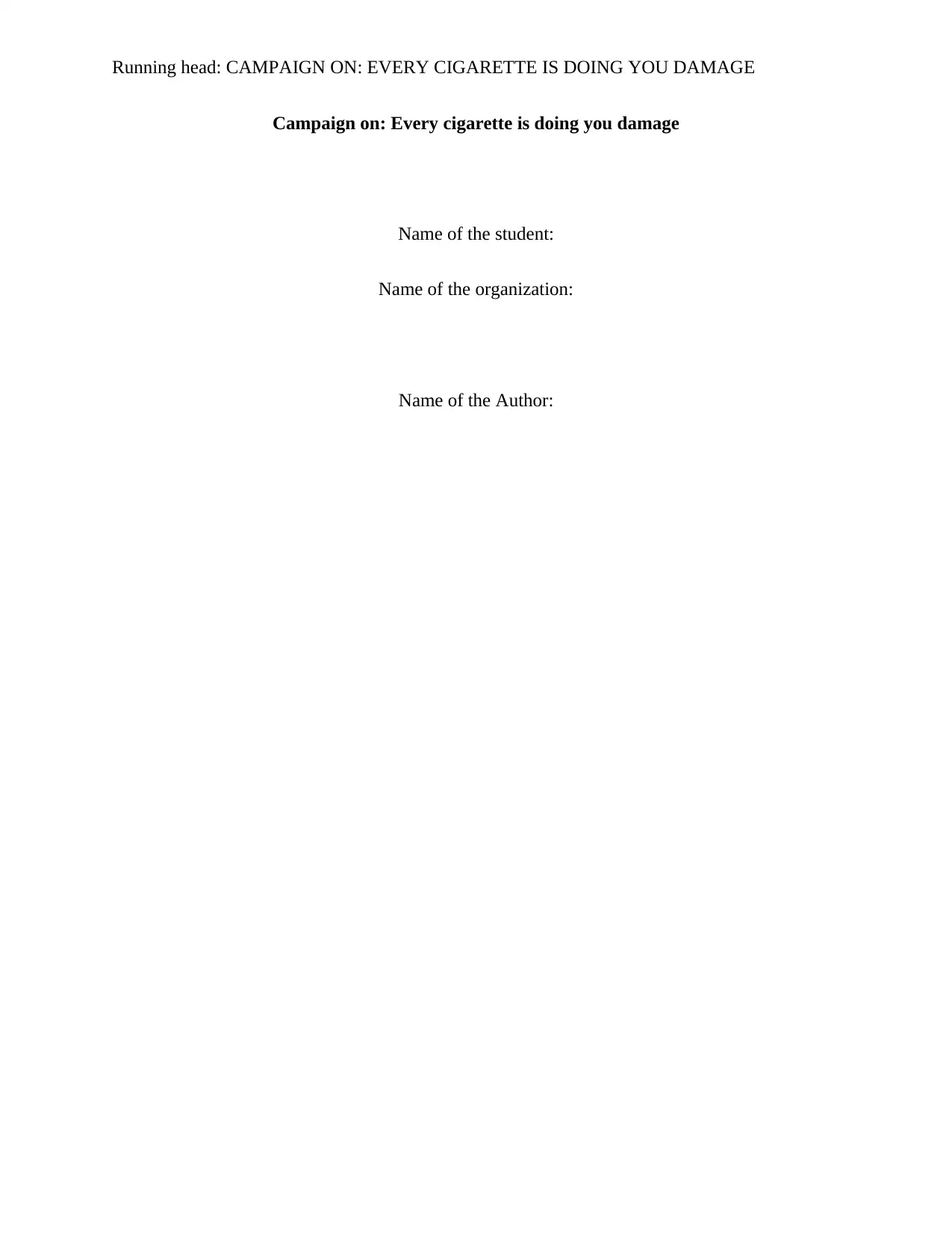
Running head: CAMPAIGN ON: EVERY CIGARETTE IS DOING YOU DAMAGE
Campaign on: Every cigarette is doing you damage
Name of the student:
Name of the organization:
Name of the Author:
Campaign on: Every cigarette is doing you damage
Name of the student:
Name of the organization:
Name of the Author:
Paraphrase This Document
Need a fresh take? Get an instant paraphrase of this document with our AI Paraphraser
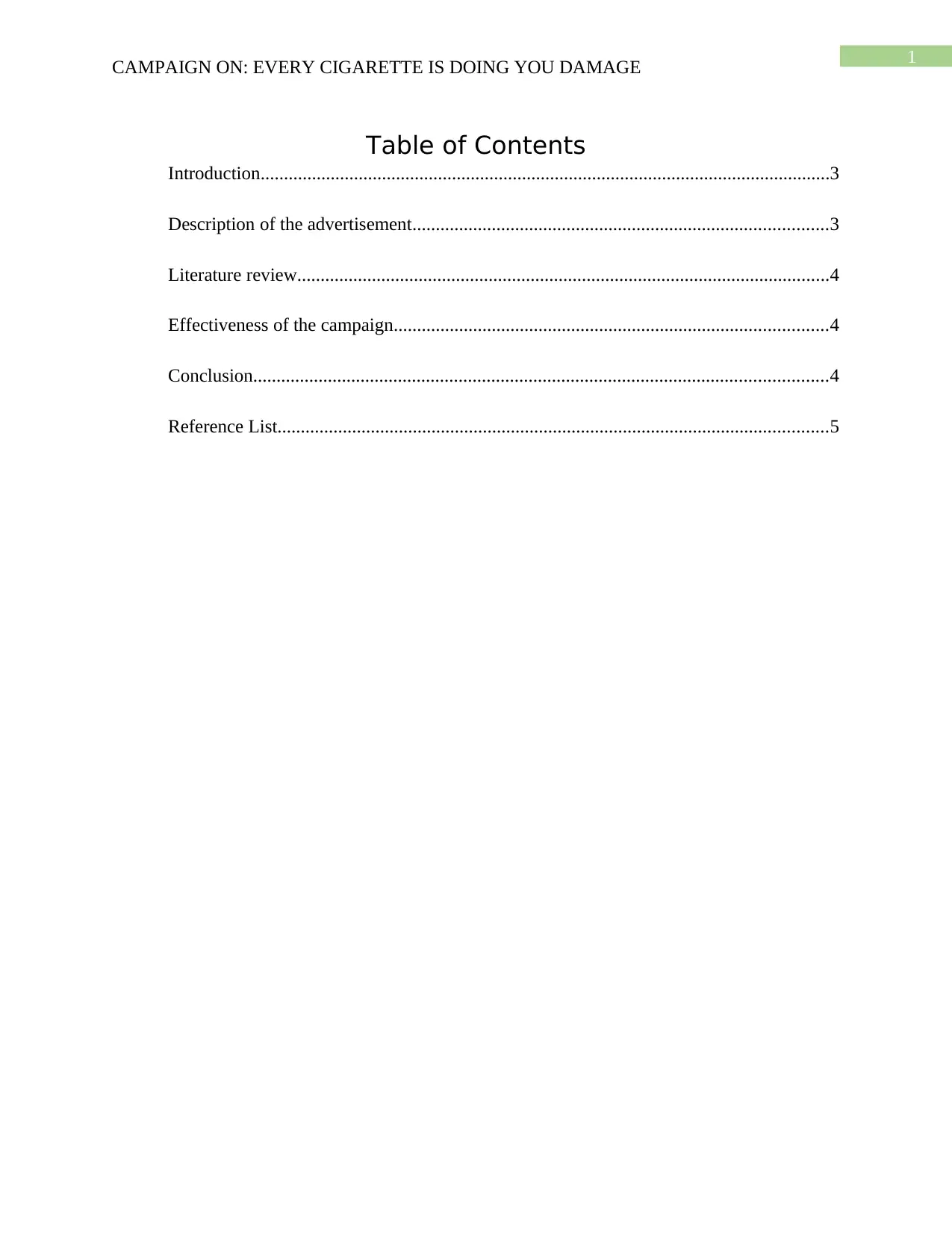
1
CAMPAIGN ON: EVERY CIGARETTE IS DOING YOU DAMAGE
Table of Contents
Introduction..........................................................................................................................3
Description of the advertisement.........................................................................................3
Literature review..................................................................................................................4
Effectiveness of the campaign.............................................................................................4
Conclusion...........................................................................................................................4
Reference List......................................................................................................................5
CAMPAIGN ON: EVERY CIGARETTE IS DOING YOU DAMAGE
Table of Contents
Introduction..........................................................................................................................3
Description of the advertisement.........................................................................................3
Literature review..................................................................................................................4
Effectiveness of the campaign.............................................................................................4
Conclusion...........................................................................................................................4
Reference List......................................................................................................................5
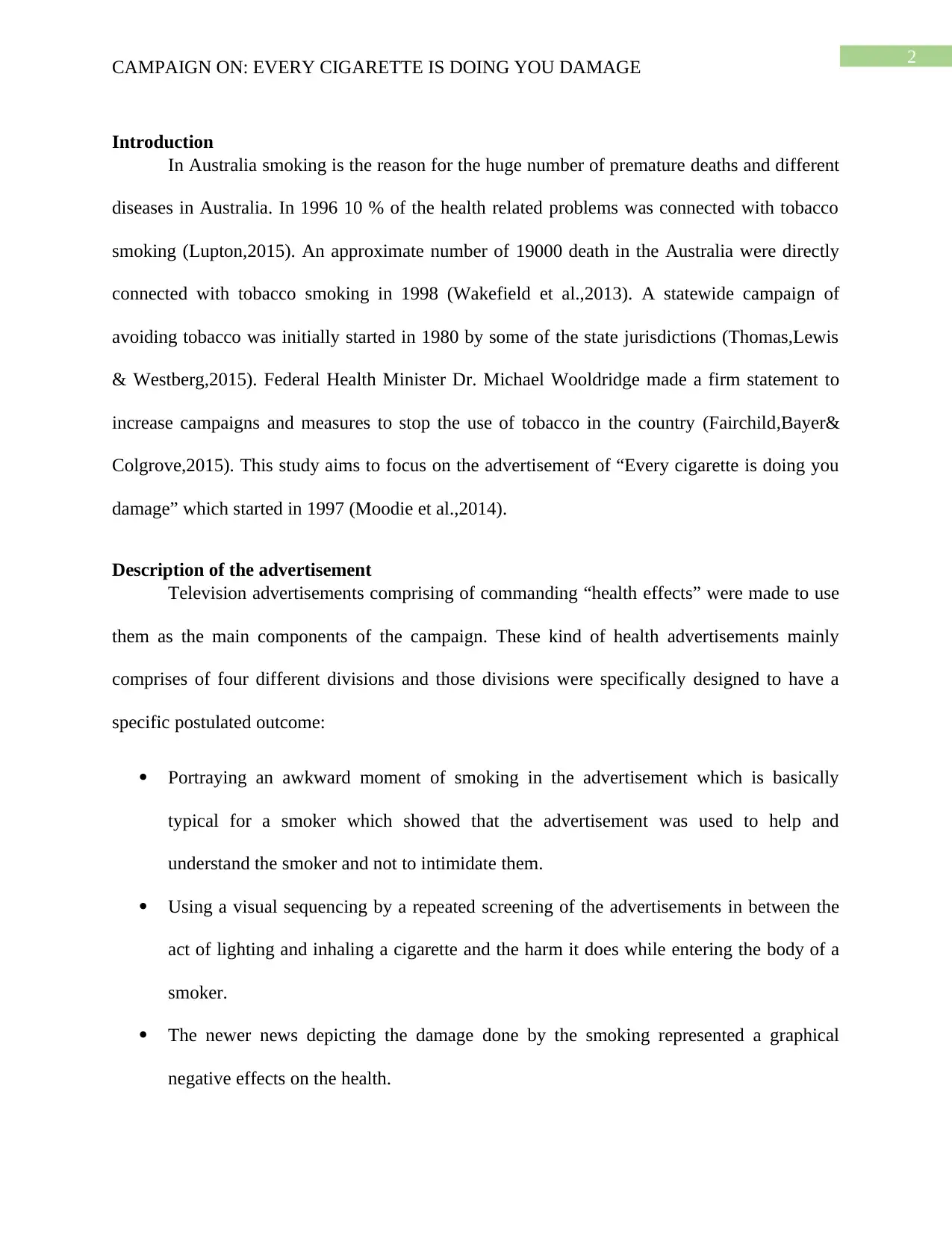
2
CAMPAIGN ON: EVERY CIGARETTE IS DOING YOU DAMAGE
Introduction
In Australia smoking is the reason for the huge number of premature deaths and different
diseases in Australia. In 1996 10 % of the health related problems was connected with tobacco
smoking (Lupton,2015). An approximate number of 19000 death in the Australia were directly
connected with tobacco smoking in 1998 (Wakefield et al.,2013). A statewide campaign of
avoiding tobacco was initially started in 1980 by some of the state jurisdictions (Thomas,Lewis
& Westberg,2015). Federal Health Minister Dr. Michael Wooldridge made a firm statement to
increase campaigns and measures to stop the use of tobacco in the country (Fairchild,Bayer&
Colgrove,2015). This study aims to focus on the advertisement of “Every cigarette is doing you
damage” which started in 1997 (Moodie et al.,2014).
Description of the advertisement
Television advertisements comprising of commanding “health effects” were made to use
them as the main components of the campaign. These kind of health advertisements mainly
comprises of four different divisions and those divisions were specifically designed to have a
specific postulated outcome:
Portraying an awkward moment of smoking in the advertisement which is basically
typical for a smoker which showed that the advertisement was used to help and
understand the smoker and not to intimidate them.
Using a visual sequencing by a repeated screening of the advertisements in between the
act of lighting and inhaling a cigarette and the harm it does while entering the body of a
smoker.
The newer news depicting the damage done by the smoking represented a graphical
negative effects on the health.
CAMPAIGN ON: EVERY CIGARETTE IS DOING YOU DAMAGE
Introduction
In Australia smoking is the reason for the huge number of premature deaths and different
diseases in Australia. In 1996 10 % of the health related problems was connected with tobacco
smoking (Lupton,2015). An approximate number of 19000 death in the Australia were directly
connected with tobacco smoking in 1998 (Wakefield et al.,2013). A statewide campaign of
avoiding tobacco was initially started in 1980 by some of the state jurisdictions (Thomas,Lewis
& Westberg,2015). Federal Health Minister Dr. Michael Wooldridge made a firm statement to
increase campaigns and measures to stop the use of tobacco in the country (Fairchild,Bayer&
Colgrove,2015). This study aims to focus on the advertisement of “Every cigarette is doing you
damage” which started in 1997 (Moodie et al.,2014).
Description of the advertisement
Television advertisements comprising of commanding “health effects” were made to use
them as the main components of the campaign. These kind of health advertisements mainly
comprises of four different divisions and those divisions were specifically designed to have a
specific postulated outcome:
Portraying an awkward moment of smoking in the advertisement which is basically
typical for a smoker which showed that the advertisement was used to help and
understand the smoker and not to intimidate them.
Using a visual sequencing by a repeated screening of the advertisements in between the
act of lighting and inhaling a cigarette and the harm it does while entering the body of a
smoker.
The newer news depicting the damage done by the smoking represented a graphical
negative effects on the health.
⊘ This is a preview!⊘
Do you want full access?
Subscribe today to unlock all pages.

Trusted by 1+ million students worldwide
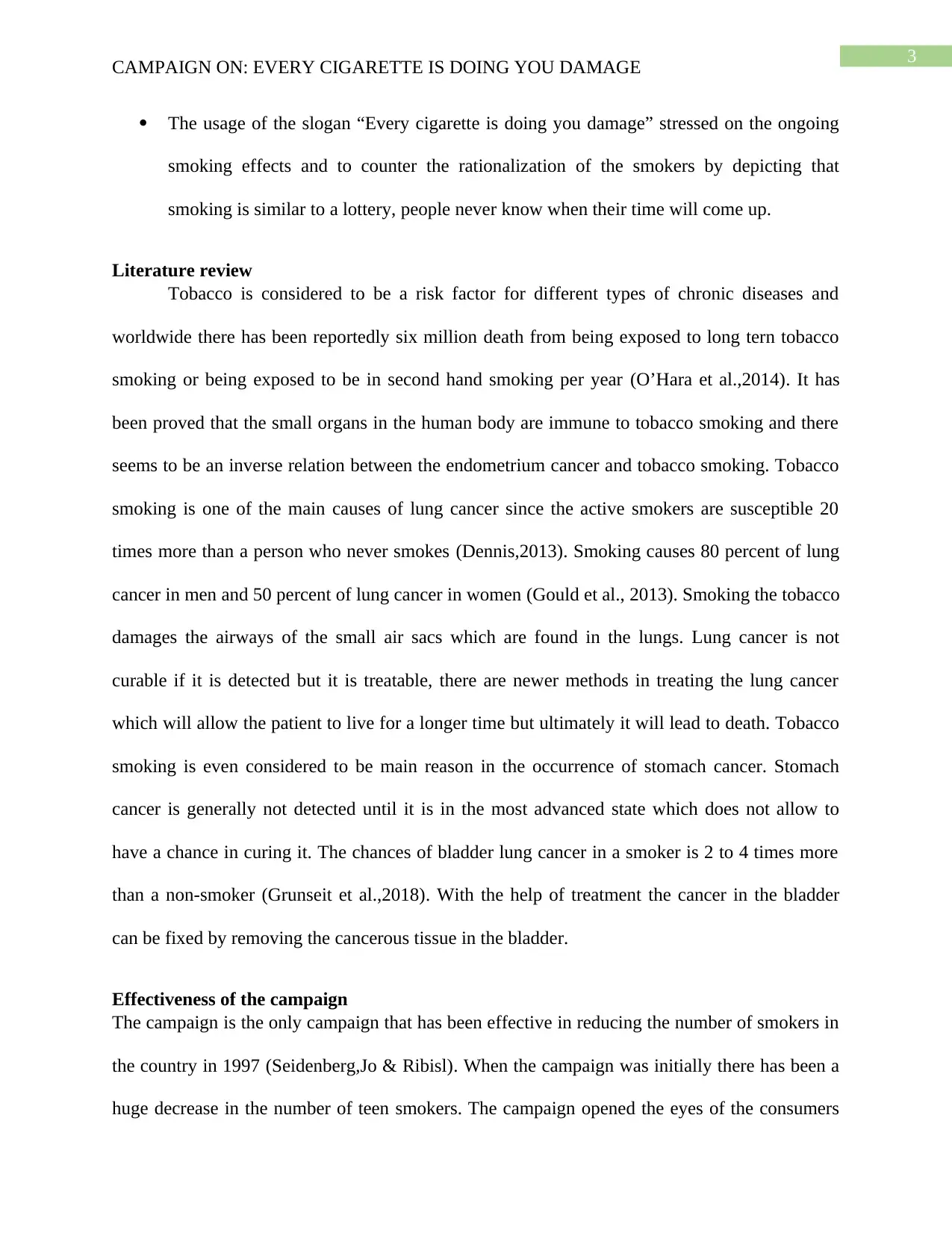
3
CAMPAIGN ON: EVERY CIGARETTE IS DOING YOU DAMAGE
The usage of the slogan “Every cigarette is doing you damage” stressed on the ongoing
smoking effects and to counter the rationalization of the smokers by depicting that
smoking is similar to a lottery, people never know when their time will come up.
Literature review
Tobacco is considered to be a risk factor for different types of chronic diseases and
worldwide there has been reportedly six million death from being exposed to long tern tobacco
smoking or being exposed to be in second hand smoking per year (O’Hara et al.,2014). It has
been proved that the small organs in the human body are immune to tobacco smoking and there
seems to be an inverse relation between the endometrium cancer and tobacco smoking. Tobacco
smoking is one of the main causes of lung cancer since the active smokers are susceptible 20
times more than a person who never smokes (Dennis,2013). Smoking causes 80 percent of lung
cancer in men and 50 percent of lung cancer in women (Gould et al., 2013). Smoking the tobacco
damages the airways of the small air sacs which are found in the lungs. Lung cancer is not
curable if it is detected but it is treatable, there are newer methods in treating the lung cancer
which will allow the patient to live for a longer time but ultimately it will lead to death. Tobacco
smoking is even considered to be main reason in the occurrence of stomach cancer. Stomach
cancer is generally not detected until it is in the most advanced state which does not allow to
have a chance in curing it. The chances of bladder lung cancer in a smoker is 2 to 4 times more
than a non-smoker (Grunseit et al.,2018). With the help of treatment the cancer in the bladder
can be fixed by removing the cancerous tissue in the bladder.
Effectiveness of the campaign
The campaign is the only campaign that has been effective in reducing the number of smokers in
the country in 1997 (Seidenberg,Jo & Ribisl). When the campaign was initially there has been a
huge decrease in the number of teen smokers. The campaign opened the eyes of the consumers
CAMPAIGN ON: EVERY CIGARETTE IS DOING YOU DAMAGE
The usage of the slogan “Every cigarette is doing you damage” stressed on the ongoing
smoking effects and to counter the rationalization of the smokers by depicting that
smoking is similar to a lottery, people never know when their time will come up.
Literature review
Tobacco is considered to be a risk factor for different types of chronic diseases and
worldwide there has been reportedly six million death from being exposed to long tern tobacco
smoking or being exposed to be in second hand smoking per year (O’Hara et al.,2014). It has
been proved that the small organs in the human body are immune to tobacco smoking and there
seems to be an inverse relation between the endometrium cancer and tobacco smoking. Tobacco
smoking is one of the main causes of lung cancer since the active smokers are susceptible 20
times more than a person who never smokes (Dennis,2013). Smoking causes 80 percent of lung
cancer in men and 50 percent of lung cancer in women (Gould et al., 2013). Smoking the tobacco
damages the airways of the small air sacs which are found in the lungs. Lung cancer is not
curable if it is detected but it is treatable, there are newer methods in treating the lung cancer
which will allow the patient to live for a longer time but ultimately it will lead to death. Tobacco
smoking is even considered to be main reason in the occurrence of stomach cancer. Stomach
cancer is generally not detected until it is in the most advanced state which does not allow to
have a chance in curing it. The chances of bladder lung cancer in a smoker is 2 to 4 times more
than a non-smoker (Grunseit et al.,2018). With the help of treatment the cancer in the bladder
can be fixed by removing the cancerous tissue in the bladder.
Effectiveness of the campaign
The campaign is the only campaign that has been effective in reducing the number of smokers in
the country in 1997 (Seidenberg,Jo & Ribisl). When the campaign was initially there has been a
huge decrease in the number of teen smokers. The campaign opened the eyes of the consumers
Paraphrase This Document
Need a fresh take? Get an instant paraphrase of this document with our AI Paraphraser
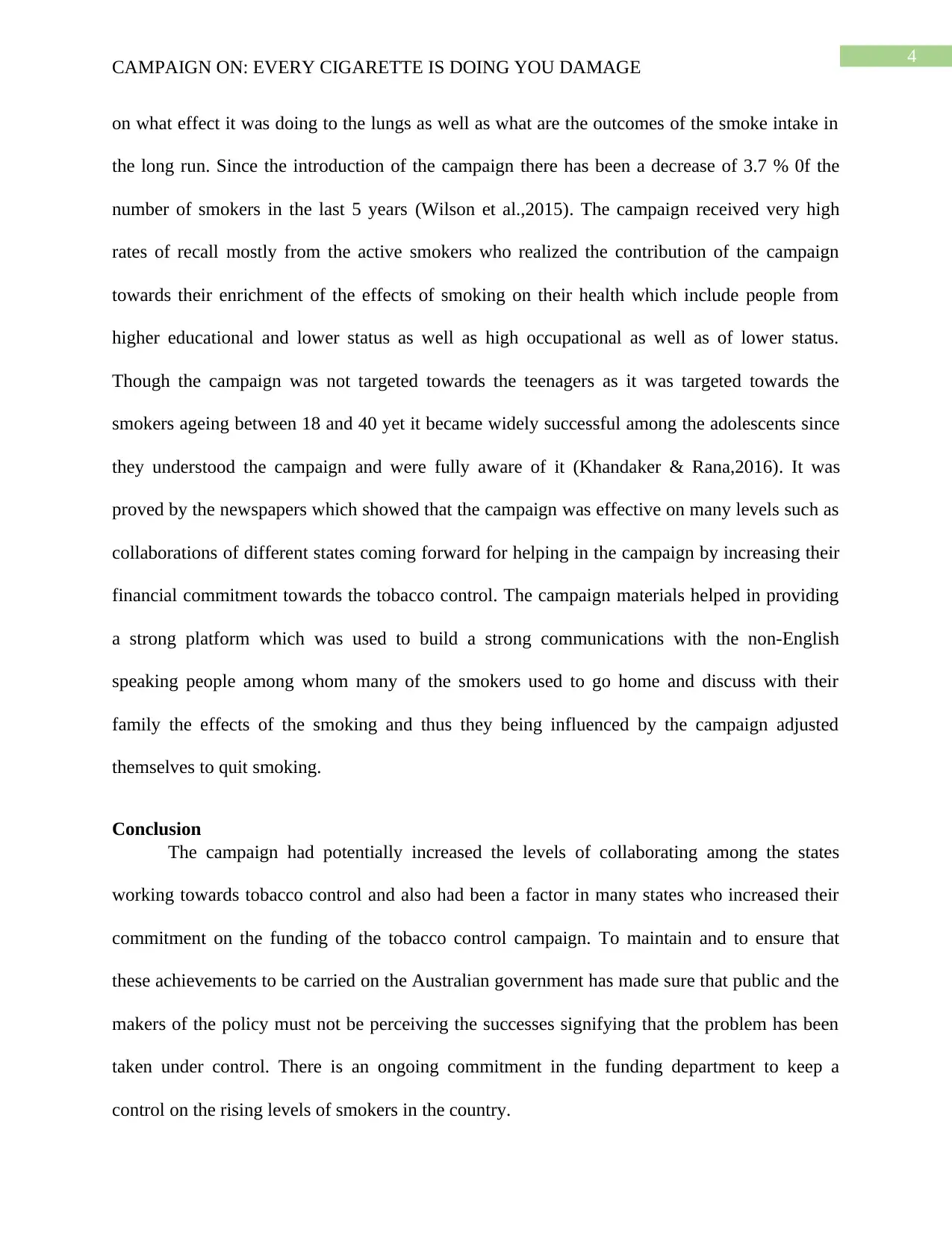
4
CAMPAIGN ON: EVERY CIGARETTE IS DOING YOU DAMAGE
on what effect it was doing to the lungs as well as what are the outcomes of the smoke intake in
the long run. Since the introduction of the campaign there has been a decrease of 3.7 % 0f the
number of smokers in the last 5 years (Wilson et al.,2015). The campaign received very high
rates of recall mostly from the active smokers who realized the contribution of the campaign
towards their enrichment of the effects of smoking on their health which include people from
higher educational and lower status as well as high occupational as well as of lower status.
Though the campaign was not targeted towards the teenagers as it was targeted towards the
smokers ageing between 18 and 40 yet it became widely successful among the adolescents since
they understood the campaign and were fully aware of it (Khandaker & Rana,2016). It was
proved by the newspapers which showed that the campaign was effective on many levels such as
collaborations of different states coming forward for helping in the campaign by increasing their
financial commitment towards the tobacco control. The campaign materials helped in providing
a strong platform which was used to build a strong communications with the non-English
speaking people among whom many of the smokers used to go home and discuss with their
family the effects of the smoking and thus they being influenced by the campaign adjusted
themselves to quit smoking.
Conclusion
The campaign had potentially increased the levels of collaborating among the states
working towards tobacco control and also had been a factor in many states who increased their
commitment on the funding of the tobacco control campaign. To maintain and to ensure that
these achievements to be carried on the Australian government has made sure that public and the
makers of the policy must not be perceiving the successes signifying that the problem has been
taken under control. There is an ongoing commitment in the funding department to keep a
control on the rising levels of smokers in the country.
CAMPAIGN ON: EVERY CIGARETTE IS DOING YOU DAMAGE
on what effect it was doing to the lungs as well as what are the outcomes of the smoke intake in
the long run. Since the introduction of the campaign there has been a decrease of 3.7 % 0f the
number of smokers in the last 5 years (Wilson et al.,2015). The campaign received very high
rates of recall mostly from the active smokers who realized the contribution of the campaign
towards their enrichment of the effects of smoking on their health which include people from
higher educational and lower status as well as high occupational as well as of lower status.
Though the campaign was not targeted towards the teenagers as it was targeted towards the
smokers ageing between 18 and 40 yet it became widely successful among the adolescents since
they understood the campaign and were fully aware of it (Khandaker & Rana,2016). It was
proved by the newspapers which showed that the campaign was effective on many levels such as
collaborations of different states coming forward for helping in the campaign by increasing their
financial commitment towards the tobacco control. The campaign materials helped in providing
a strong platform which was used to build a strong communications with the non-English
speaking people among whom many of the smokers used to go home and discuss with their
family the effects of the smoking and thus they being influenced by the campaign adjusted
themselves to quit smoking.
Conclusion
The campaign had potentially increased the levels of collaborating among the states
working towards tobacco control and also had been a factor in many states who increased their
commitment on the funding of the tobacco control campaign. To maintain and to ensure that
these achievements to be carried on the Australian government has made sure that public and the
makers of the policy must not be perceiving the successes signifying that the problem has been
taken under control. There is an ongoing commitment in the funding department to keep a
control on the rising levels of smokers in the country.
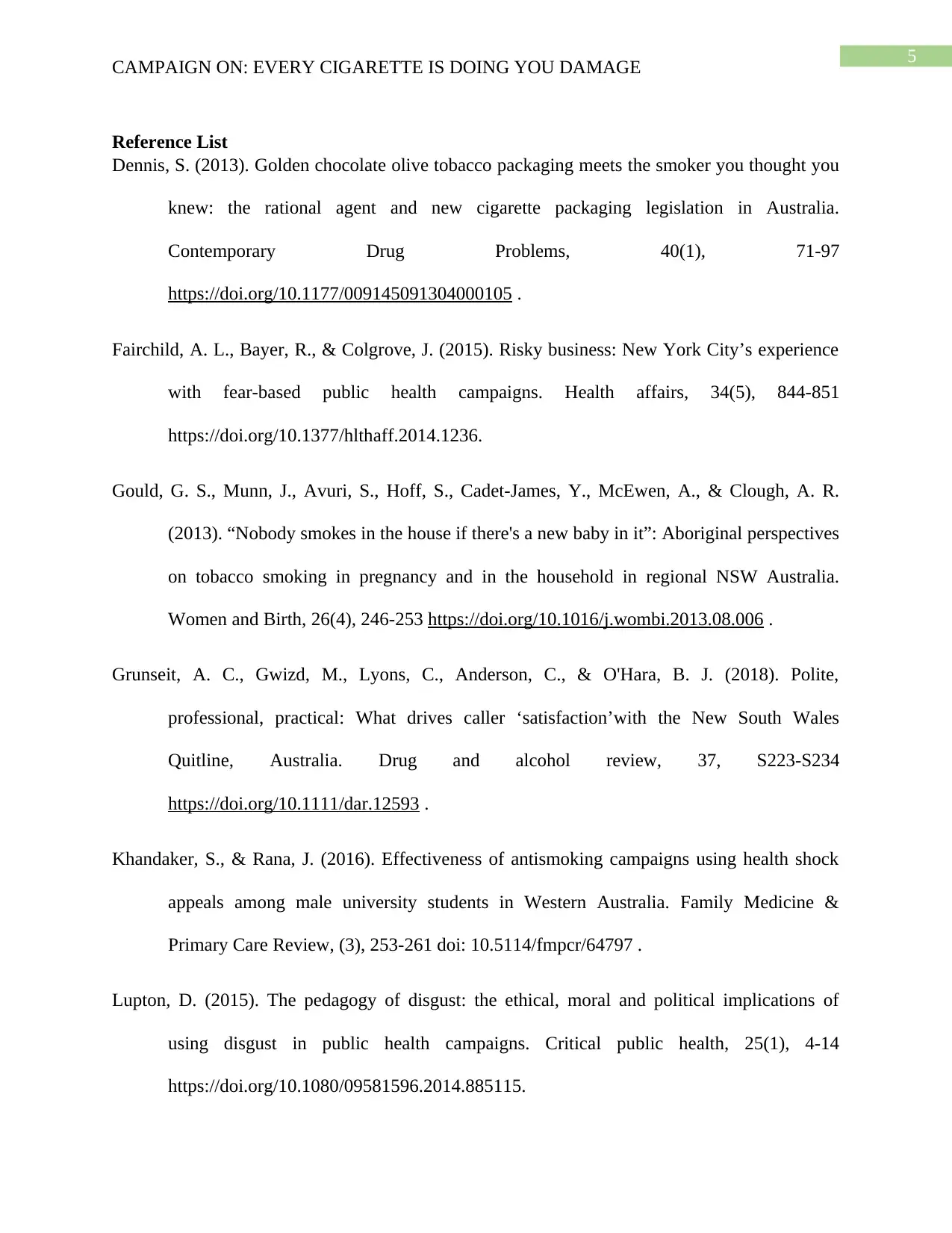
5
CAMPAIGN ON: EVERY CIGARETTE IS DOING YOU DAMAGE
Reference List
Dennis, S. (2013). Golden chocolate olive tobacco packaging meets the smoker you thought you
knew: the rational agent and new cigarette packaging legislation in Australia.
Contemporary Drug Problems, 40(1), 71-97
https://doi.org/10.1177/009145091304000105 .
Fairchild, A. L., Bayer, R., & Colgrove, J. (2015). Risky business: New York City’s experience
with fear-based public health campaigns. Health affairs, 34(5), 844-851
https://doi.org/10.1377/hlthaff.2014.1236.
Gould, G. S., Munn, J., Avuri, S., Hoff, S., Cadet-James, Y., McEwen, A., & Clough, A. R.
(2013). “Nobody smokes in the house if there's a new baby in it”: Aboriginal perspectives
on tobacco smoking in pregnancy and in the household in regional NSW Australia.
Women and Birth, 26(4), 246-253 https://doi.org/10.1016/j.wombi.2013.08.006 .
Grunseit, A. C., Gwizd, M., Lyons, C., Anderson, C., & O'Hara, B. J. (2018). Polite,
professional, practical: What drives caller ‘satisfaction’with the New South Wales
Quitline, Australia. Drug and alcohol review, 37, S223-S234
https://doi.org/10.1111/dar.12593 .
Khandaker, S., & Rana, J. (2016). Effectiveness of antismoking campaigns using health shock
appeals among male university students in Western Australia. Family Medicine &
Primary Care Review, (3), 253-261 doi: 10.5114/fmpcr/64797 .
Lupton, D. (2015). The pedagogy of disgust: the ethical, moral and political implications of
using disgust in public health campaigns. Critical public health, 25(1), 4-14
https://doi.org/10.1080/09581596.2014.885115.
CAMPAIGN ON: EVERY CIGARETTE IS DOING YOU DAMAGE
Reference List
Dennis, S. (2013). Golden chocolate olive tobacco packaging meets the smoker you thought you
knew: the rational agent and new cigarette packaging legislation in Australia.
Contemporary Drug Problems, 40(1), 71-97
https://doi.org/10.1177/009145091304000105 .
Fairchild, A. L., Bayer, R., & Colgrove, J. (2015). Risky business: New York City’s experience
with fear-based public health campaigns. Health affairs, 34(5), 844-851
https://doi.org/10.1377/hlthaff.2014.1236.
Gould, G. S., Munn, J., Avuri, S., Hoff, S., Cadet-James, Y., McEwen, A., & Clough, A. R.
(2013). “Nobody smokes in the house if there's a new baby in it”: Aboriginal perspectives
on tobacco smoking in pregnancy and in the household in regional NSW Australia.
Women and Birth, 26(4), 246-253 https://doi.org/10.1016/j.wombi.2013.08.006 .
Grunseit, A. C., Gwizd, M., Lyons, C., Anderson, C., & O'Hara, B. J. (2018). Polite,
professional, practical: What drives caller ‘satisfaction’with the New South Wales
Quitline, Australia. Drug and alcohol review, 37, S223-S234
https://doi.org/10.1111/dar.12593 .
Khandaker, S., & Rana, J. (2016). Effectiveness of antismoking campaigns using health shock
appeals among male university students in Western Australia. Family Medicine &
Primary Care Review, (3), 253-261 doi: 10.5114/fmpcr/64797 .
Lupton, D. (2015). The pedagogy of disgust: the ethical, moral and political implications of
using disgust in public health campaigns. Critical public health, 25(1), 4-14
https://doi.org/10.1080/09581596.2014.885115.
⊘ This is a preview!⊘
Do you want full access?
Subscribe today to unlock all pages.

Trusted by 1+ million students worldwide
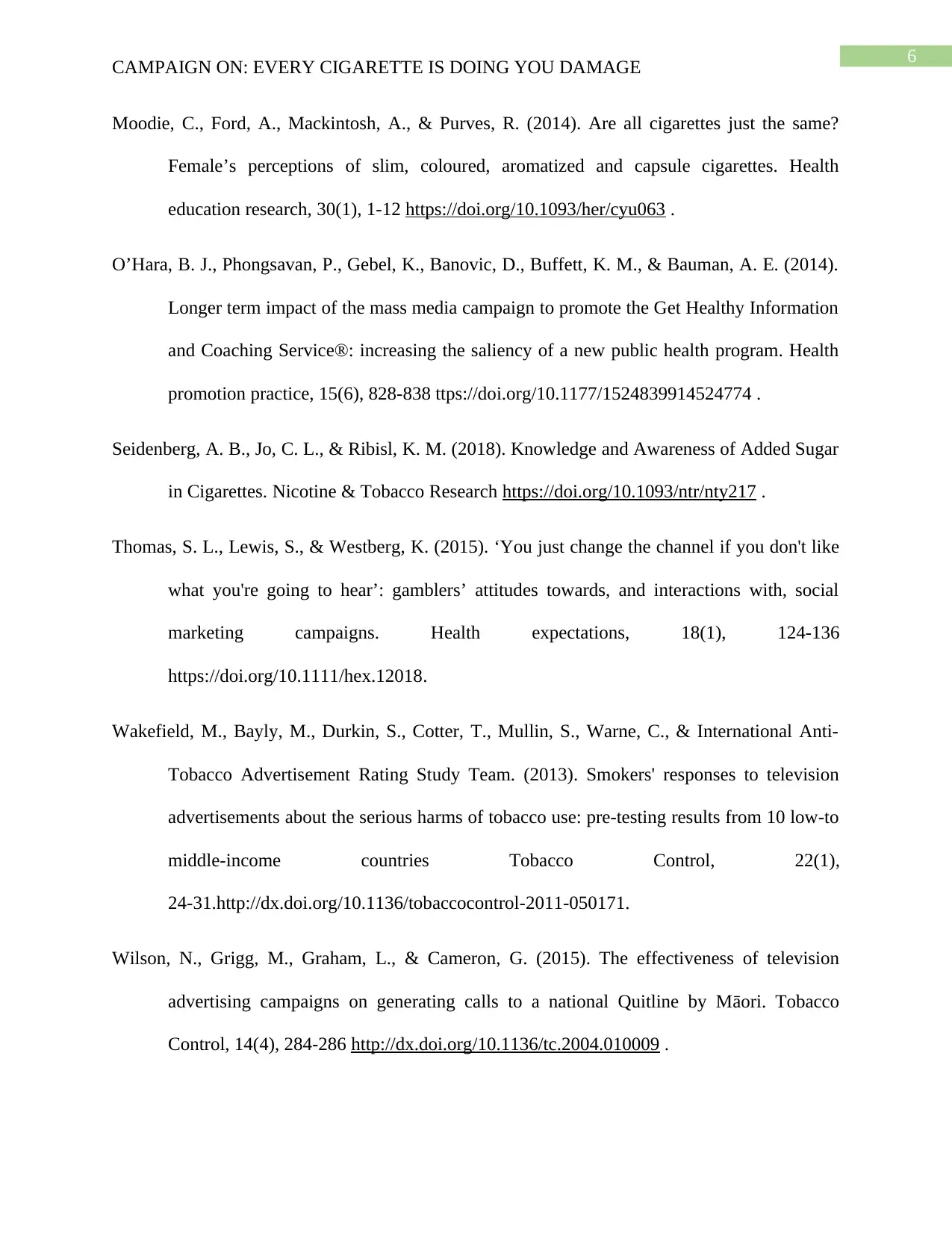
6
CAMPAIGN ON: EVERY CIGARETTE IS DOING YOU DAMAGE
Moodie, C., Ford, A., Mackintosh, A., & Purves, R. (2014). Are all cigarettes just the same?
Female’s perceptions of slim, coloured, aromatized and capsule cigarettes. Health
education research, 30(1), 1-12 https://doi.org/10.1093/her/cyu063 .
O’Hara, B. J., Phongsavan, P., Gebel, K., Banovic, D., Buffett, K. M., & Bauman, A. E. (2014).
Longer term impact of the mass media campaign to promote the Get Healthy Information
and Coaching Service®: increasing the saliency of a new public health program. Health
promotion practice, 15(6), 828-838 ttps://doi.org/10.1177/1524839914524774 .
Seidenberg, A. B., Jo, C. L., & Ribisl, K. M. (2018). Knowledge and Awareness of Added Sugar
in Cigarettes. Nicotine & Tobacco Research https://doi.org/10.1093/ntr/nty217 .
Thomas, S. L., Lewis, S., & Westberg, K. (2015). ‘You just change the channel if you don't like
what you're going to hear’: gamblers’ attitudes towards, and interactions with, social
marketing campaigns. Health expectations, 18(1), 124-136
https://doi.org/10.1111/hex.12018.
Wakefield, M., Bayly, M., Durkin, S., Cotter, T., Mullin, S., Warne, C., & International Anti-
Tobacco Advertisement Rating Study Team. (2013). Smokers' responses to television
advertisements about the serious harms of tobacco use: pre-testing results from 10 low-to
middle-income countries Tobacco Control, 22(1),
24-31.http://dx.doi.org/10.1136/tobaccocontrol-2011-050171.
Wilson, N., Grigg, M., Graham, L., & Cameron, G. (2015). The effectiveness of television
advertising campaigns on generating calls to a national Quitline by Māori. Tobacco
Control, 14(4), 284-286 http://dx.doi.org/10.1136/tc.2004.010009 .
CAMPAIGN ON: EVERY CIGARETTE IS DOING YOU DAMAGE
Moodie, C., Ford, A., Mackintosh, A., & Purves, R. (2014). Are all cigarettes just the same?
Female’s perceptions of slim, coloured, aromatized and capsule cigarettes. Health
education research, 30(1), 1-12 https://doi.org/10.1093/her/cyu063 .
O’Hara, B. J., Phongsavan, P., Gebel, K., Banovic, D., Buffett, K. M., & Bauman, A. E. (2014).
Longer term impact of the mass media campaign to promote the Get Healthy Information
and Coaching Service®: increasing the saliency of a new public health program. Health
promotion practice, 15(6), 828-838 ttps://doi.org/10.1177/1524839914524774 .
Seidenberg, A. B., Jo, C. L., & Ribisl, K. M. (2018). Knowledge and Awareness of Added Sugar
in Cigarettes. Nicotine & Tobacco Research https://doi.org/10.1093/ntr/nty217 .
Thomas, S. L., Lewis, S., & Westberg, K. (2015). ‘You just change the channel if you don't like
what you're going to hear’: gamblers’ attitudes towards, and interactions with, social
marketing campaigns. Health expectations, 18(1), 124-136
https://doi.org/10.1111/hex.12018.
Wakefield, M., Bayly, M., Durkin, S., Cotter, T., Mullin, S., Warne, C., & International Anti-
Tobacco Advertisement Rating Study Team. (2013). Smokers' responses to television
advertisements about the serious harms of tobacco use: pre-testing results from 10 low-to
middle-income countries Tobacco Control, 22(1),
24-31.http://dx.doi.org/10.1136/tobaccocontrol-2011-050171.
Wilson, N., Grigg, M., Graham, L., & Cameron, G. (2015). The effectiveness of television
advertising campaigns on generating calls to a national Quitline by Māori. Tobacco
Control, 14(4), 284-286 http://dx.doi.org/10.1136/tc.2004.010009 .
1 out of 7
Related Documents
Your All-in-One AI-Powered Toolkit for Academic Success.
+13062052269
info@desklib.com
Available 24*7 on WhatsApp / Email
![[object Object]](/_next/static/media/star-bottom.7253800d.svg)
Unlock your academic potential
Copyright © 2020–2025 A2Z Services. All Rights Reserved. Developed and managed by ZUCOL.





